Key takeaways:
- Rejection in art is subjective and serves as motivation to refine one’s artistic voice and skills.
- Emotional responses to rejection, such as anger and self-doubt, are normal and essential for growth.
- Constructive feedback and resilience are crucial to overcoming rejection and enhancing artistic practice.
- Viewing rejection as an opportunity can lead to unexpected creative breakthroughs and future success.
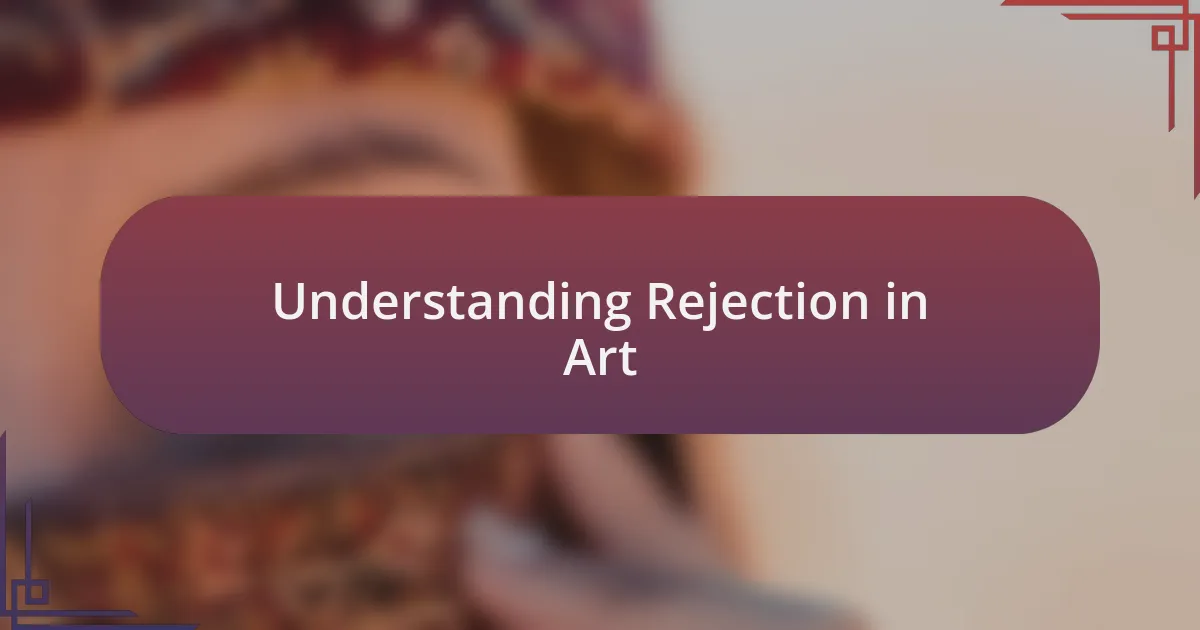
Understanding Rejection in Art
Rejection in the art world can feel like a punch to the gut, can’t it? I remember the first time I submitted my work to a gallery, filled with excitement and a dash of naive hope. When the rejection letter came, I experienced a whirlwind of emotions—from disbelief to disappointment—but it turned into a pivotal moment that inspired me to dig deeper into my artistic voice.
Art is inherently subjective, and what resonates with one person may not touch another. This realization became clear to me when I shared a series of paintings with close friends. While some praised my techniques, others simply didn’t connect with the theme. I wondered, was my work not relatable, or was it merely a reflection of varying tastes? I learned that rejection isn’t a judgment of my worth but rather a reminder of the diverse perspectives that exist in the world.
Sometimes, I think about famous artists who faced multiple rejections before finding their success. Can you imagine if they had given up? The journeys of Van Gogh or Frida Kahlo, filled with numerous “no’s,” remind me that each rejection can be a stepping stone toward growth. It’s about taking those experiences and channeling them into our craft, refining our skills, and ultimately developing a thick skin.
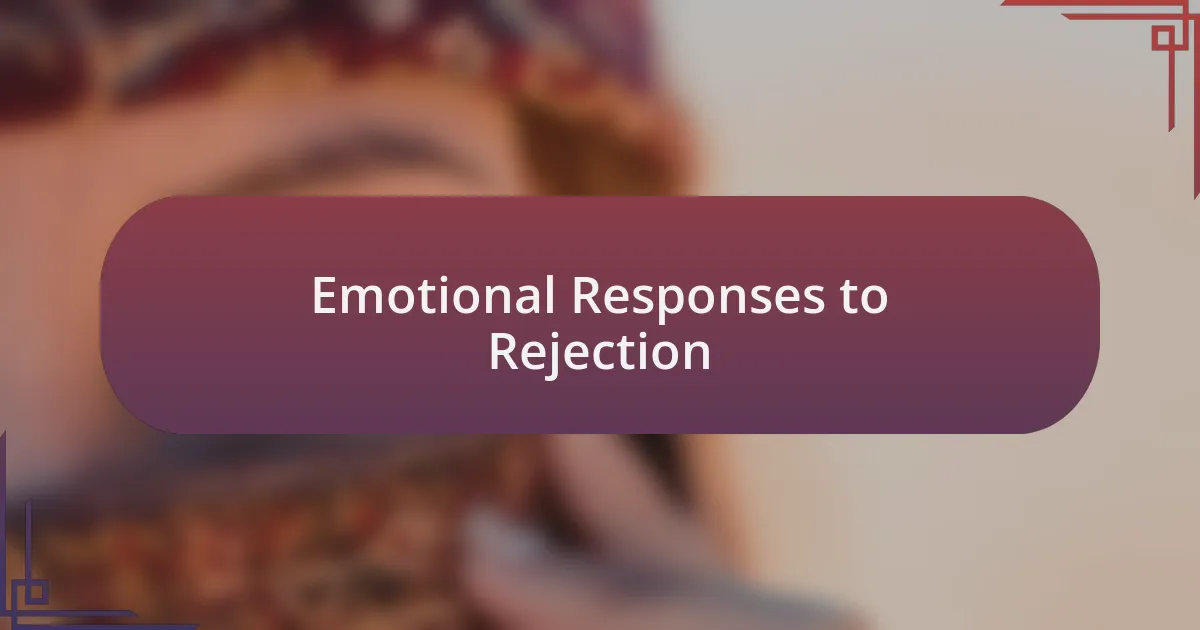
Emotional Responses to Rejection
Receiving rejection can trigger a storm of emotions. I vividly recall how my heart sank when I saw that envelope containing a rejection slip from my dream exhibition. That moment transformed my excitement into self-doubt and frustration, leaving me questioning if my artistic journey was even worth pursuing.
As I processed the rejection, I noticed how anger and sadness intermingled, almost paralyzing me for a time. I found myself asking, “Am I truly good enough?” Eventually, acknowledging these feelings allowed me to face them head-on. I realized that these emotional responses are not just normal but essential to the growth process. They push me to confront my vulnerabilities and motivate me to create with more intention.
Interestingly, over time, I’ve learned to view rejection as a rite of passage rather than a failure. It’s not uncommon for my initial sting of rejection to evolve into a creative challenge that reignites my passion. I’ve found that embracing the vulnerability of rejection can lead to profound artistic breakthroughs, sparking new inspirations that I might have missed before. Isn’t it fascinating how a setback can sometimes light the way forward?
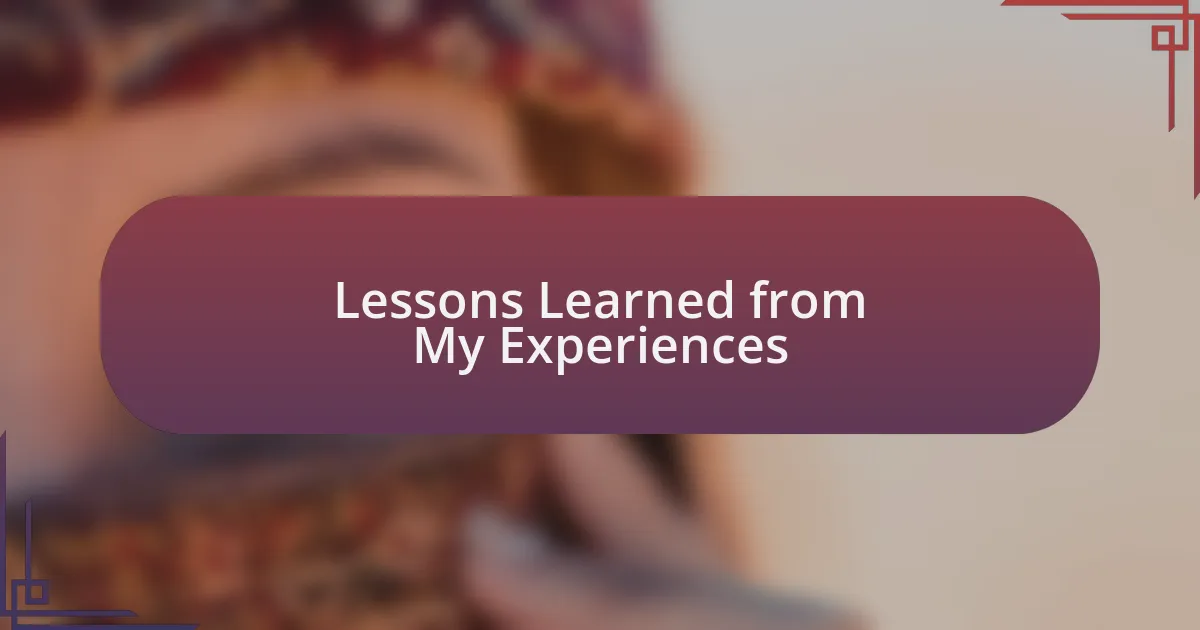
Lessons Learned from My Experiences
One of the most important lessons I’ve learned from rejection is the value of resilience. I remember submitting a piece to a local gallery that I felt was my best work yet. When I received the rejection notice, I could have easily given up, but instead, I took a step back. I reflected on what could have been improved, which led to a significant turning point in my artistic style. Have you ever felt that urge to throw in the towel? That’s when I realized that each rejection is an opportunity to grow stronger and refine my craft.
Another insight that emerged from my experiences is the importance of feedback. After one particularly tough rejection, I sought out critiques from fellow artists. I discovered perspectives I hadn’t considered, which illuminated glaring flaws in my approach. This exchange not only enhanced my skills but also built a supportive network of creative minds. Seeking feedback can be intimidating, but isn’t it remarkable how constructive criticism can be a powerful catalyst for improvement?
Lastly, I’ve come to appreciate the role of timing in the journey of any artist. Some of my works have been rejected only to gain recognition later on. There’s a piece I submitted multiple times before it finally found a home at an exhibition. It taught me that what isn’t accepted today may resonate at a different moment, revealing the ever-changing nature of art and perception. Isn’t it intriguing how our creations evolve alongside our experiences?
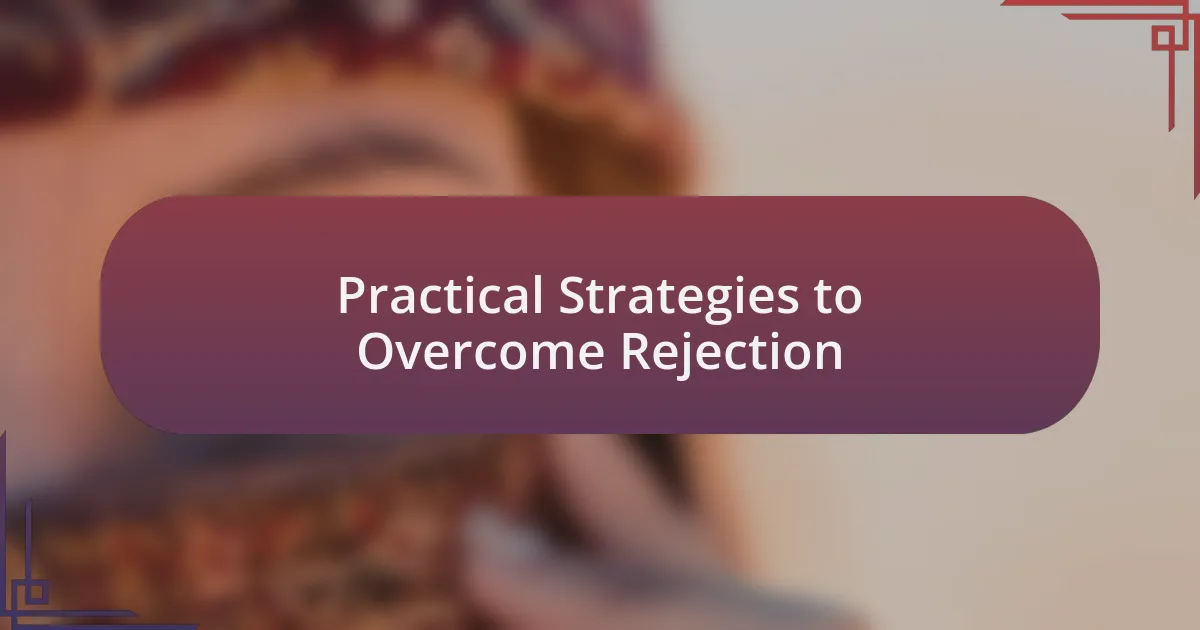
Practical Strategies to Overcome Rejection
One practical strategy to overcome rejection is to cultivate a routine of self-reflection after each setback. I often take a moment to jot down my thoughts immediately following a rejection. This practice helps me articulate my feelings and pinpoint specific areas for improvement. Have you tried this? It can be a bit cathartic and leads to clarity that often transforms frustration into motivation.
Connecting with others in your field can be incredibly powerful. I recall a time when I felt disheartened after my writing was dismissed by a publisher. Instead of wallowing in disappointment, I reached out to fellow writers. They shared their own stories of rejection and resilience, which not only comforted me but also inspired me to push forward. Isn’t it amazing how community support can make a profound difference in our creative journeys?
Another effective approach is to set small, achievable goals in response to rejection. Whenever I face a setback, I create a list of incremental steps to improve my craft and regain my confidence. For example, after a painting was turned down, I committed to experimenting with a new technique for the next few weeks. This focused effort shifted my mindset, allowing me to see rejection as a stepping stone rather than a roadblock. Can you imagine how empowering it feels to take control of your journey in this way?
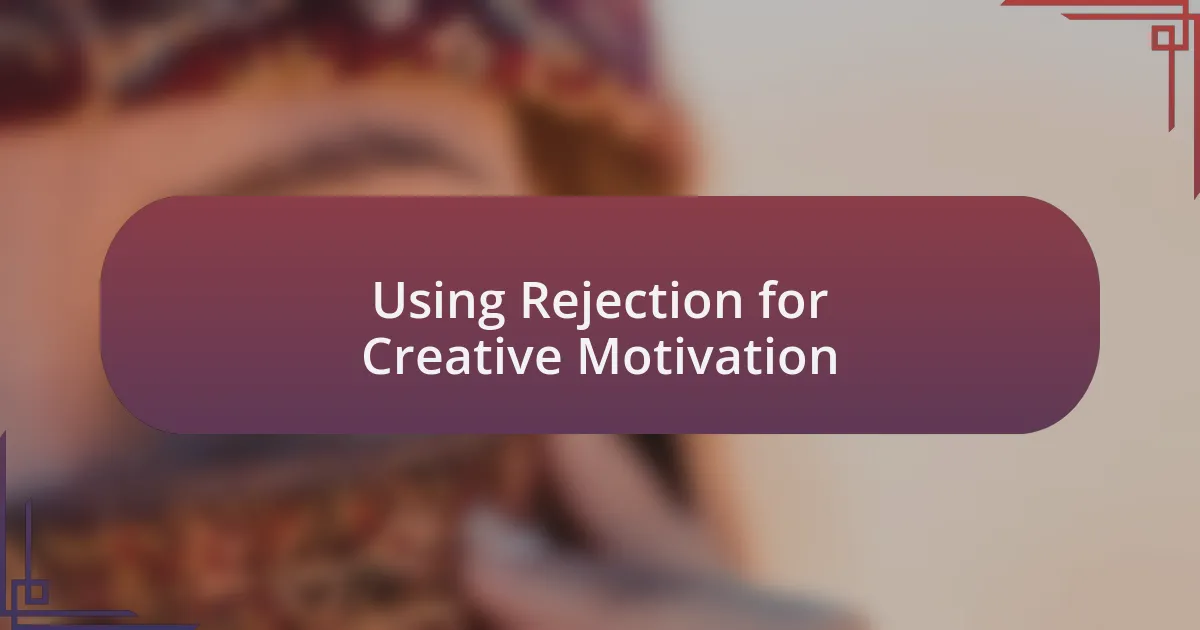
Using Rejection for Creative Motivation
Embracing rejection can spark a surprising level of creativity. I often think back to a time when my artwork was rejected from a local exhibition. Instead of feeling defeated, I channeled that energy into a new project. It became a turning point where I discovered a bold style I hadn’t previously explored. Have you ever considered how rejection might be the nudge you need to venture beyond your comfort zone?
One experience that stands out for me is when I submitted a manuscript that was met with resounding silence. In that moment, I decided to work on an entirely different genre. This shift not only rejuvenated my passion but also opened doors to an unexpected creative outlet. Isn’t it fascinating how the sting of rejection can often lead to new and exciting possibilities?
Finding inspiration in rejection can also be about setting a gritty mindset. I remember a workshop I attended where the instructor emphasized the idea of “creating despite the ‘no.’” I started to view every rejected idea as fuel for my next creative endeavor. It’s like having a reservoir of motivation to dip into during times of doubt. When was the last time you turned a rejection into a reason to create something remarkable?
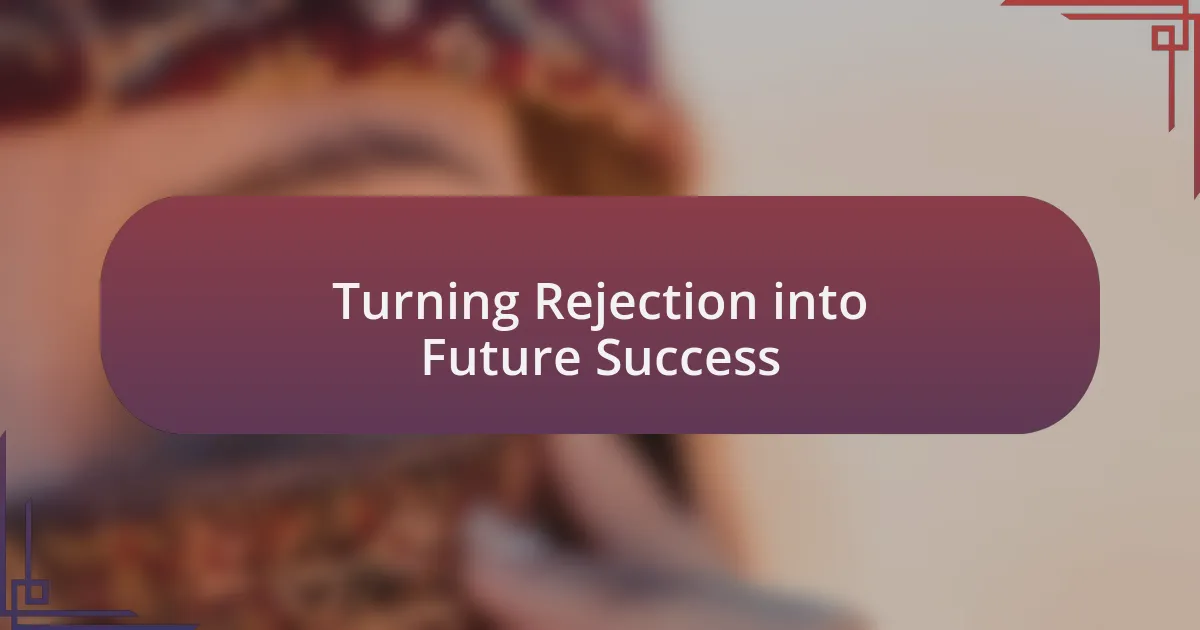
Turning Rejection into Future Success
When I think about turning rejection into future success, one memory comes to mind: my first gallery show. I vividly remember receiving feedback that my pieces weren’t “commercially viable.” At first, it stung; however, I soon realized this was an opportunity to experiment with a more niche audience. This shift in perspective led to a series of works that deeply resonated with a smaller, yet passionate, community. Have you ever noticed how the opinions of others can sometimes guide you toward what truly matters to you?
Another instance that stands out was being turned down for a prestigious artist residency. It felt like a harsh blow, but instead of wallowing in self-pity, I decided to host my own pop-up event. This decision not only gave me newfound visibility but also provided a much-needed sense of control over my narrative. Isn’t it interesting how rejection can sometimes pave the way for opportunities you’d never considered?
Sometimes, reflection is just as important as action. I like to keep a rejection journal where I write down experiences that didn’t go as planned. Revisiting these moments allows me to identify patterns in my work and grow from them. This practice has transformed my understanding of rejection into a roadmap for future success. How do you interpret your setbacks to fuel your next steps forward?